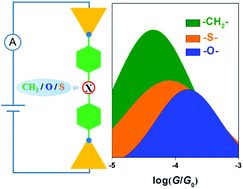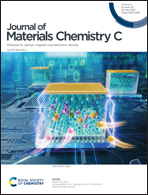Modulating electron transport through single-molecule junctions by heteroatom substitution†
Abstract
The modulation of electron transport through molecular junctions is a prerequisite for realizing single-molecule electronic devices, which remains to be a big challenge. In this work, an effective strategy using heteroatom substitution in the molecular backbone is carried out to tune the conductance of molecular junctions. Conductance measurement by the scanning tunneling microscopy break junction (STM-BJ) technique clearly shows that replacing –CH2− with –O– and –S– could significantly enhance electron tunneling through the diphenylamine-based molecules. Double and four-fold values of single-molecular conductance are achieved with S and O heteroatom substitutions, respectively. Furthermore, the theoretical calculation reveals that heteroatom substitutions lead to a smaller energy gap of the frontier molecular orbitals and larger transmission coefficient T(E) of electrons for electron tunneling, which nicely correlates with the experimental observation. The current work provides a new way to design high-performance molecular wires using heteroatom substitution.



 Please wait while we load your content...
Please wait while we load your content...